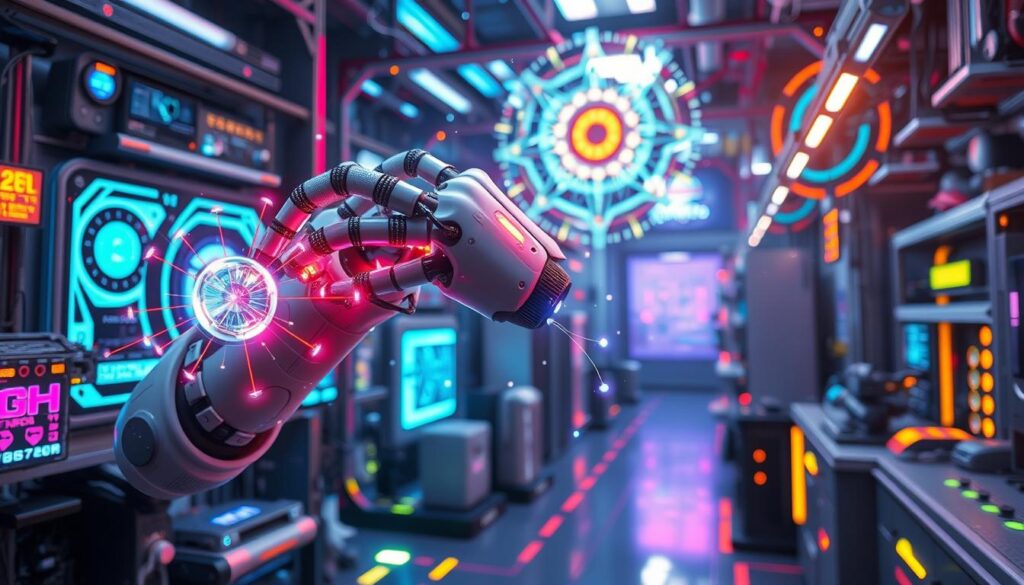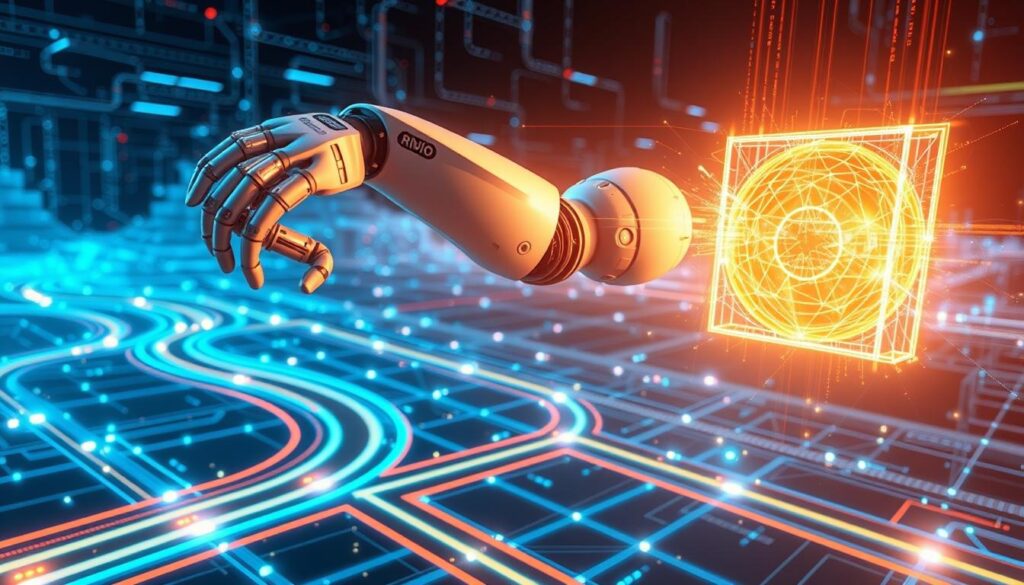The field of quantum robotics is transforming how robots move and interact. It uses quantum computing’s unique features like superposition and entanglement. This leads to the creation of advanced motion planning algorithms and control systems. These innovations aim to boost efficiency, precision, and problem-solving skills in robots.
Quantum optimization is being used to solve complex challenges in robotic motion planning. It allows robots to make more informed decisions and adapt to changing environments. The inclusion of quantum computing in robots brings about new opportunities for advanced automation and intelligent machines.
Introduction to Quantum Computing in Robotics
Quantum computing is transforming robotics by offering new solutions to complex challenges. At its core, quantum computing uses qubits, which can exist in multiple states at once. This ability, known as superposition, allows quantum computers to solve certain problems exponentially faster than traditional computers. Researchers are now exploring how to use qubits and quantum algorithms to improve robotic capabilities, especially in motion planning and control.

Quantum algorithms, like Grover’s search and Shor’s factoring, promise a significant speedup in solving complex robotic problems. These algorithms can optimize path planning, inverse kinematics, and other tasks that robots must perform quickly. By tapping into quantum parallelism, robots can process large amounts of data efficiently. This enables them to navigate complex spaces and adapt to changing situations more effectively.
The development of quantum hardware and software has made rapid progress, bringing us closer to the full potential of quantum computing in robotics. Researchers are creating quantum processors with more qubits and better error correction. This is essential for building reliable, scalable quantum systems. Moreover, the creation of quantum programming languages and frameworks, such as Qiskit and OpenQASM, is simplifying the process of designing and implementing quantum algorithms for robotics.
As quantum computing becomes more integrated into robotics, we can look forward to a new era of intelligent, adaptable robots. These robots will be able to tackle tasks that were once thought impossible. Quantum computing has the potential to open up new possibilities in robotic applications, changing how we interact with and benefit from these advanced machines.
Enhancing Robotic Motion Planning and Control with Quantum Computing
Quantum computing is set to transform robotic motion planning and control. It will allow robots to navigate complex spaces with unmatched efficiency and precision. Quantum algorithms are being used to optimize path planning and improve the stability and accuracy of robotic movements.
Quantum motion planning is a key area where quantum computing shines. Algorithms like Grover’s search and the quantum approximate optimization algorithm (QAOA) are used to find the most efficient paths. These algorithms use quantum superposition and entanglement to explore multiple paths at once. This significantly cuts down the time needed for path planning compared to traditional methods.

Quantum control is also being explored to enhance robotic movement precision and stability. It involves manipulating quantum systems to achieve specific outcomes, like precise positioning or smooth trajectory following. Researchers aim to reduce the impact of external disturbances and uncertainties, leading to more accurate and reliable motion control.
Several studies have shown the benefits of using quantum computing in robotic motion planning and control. For example:
- A team at the University of New South Wales created a quantum algorithm for path planning that outperformed classical methods in efficiency and solution quality.
- Researchers at the University of Science and Technology of China used quantum control to improve a robotic arm’s precision, achieving sub-millimeter accuracy in positioning tasks.
- A collaboration between the Massachusetts Institute of Technology and the University of Waterloo applied quantum optimization algorithms to robotic grasping and manipulation. They saw improved success rates compared to traditional methods.
As quantum computing evolves, its role in enhancing robotic motion planning and control will grow. By harnessing quantum systems’ unique properties, researchers and engineers can create more efficient, precise, and adaptable robots. These robots will be capable of handling complex tasks across various domains, from manufacturing and logistics to healthcare and space exploration.
Quantum Machine Learning for Robotic Perception
The fusion of quantum computing and machine learning is transforming robotic perception. Quantum machine learning algorithms are transforming robotic vision systems. They enable robots to recognize and classify objects more swiftly and accurately. This allows robots to better perceive and interact with their surroundings.
Quantum neural networks are a key area of promise in robotic perception. These networks leverage quantum computing’s unique capabilities to enhance robotic learning. They process data more efficiently than classical networks, enabling robots to adapt to new environments and tasks more rapidly. This makes robots more versatile and autonomous.
Quantum computer vision is another area where quantum machine learning is making significant progress. Researchers are developing algorithms that extract more meaningful features from visual data. These algorithms have the potential to enhance object detection, tracking, and segmentation tasks. These are crucial for robotic perception.
However, integrating quantum machine learning with robotic perception comes with challenges. Researchers must tackle issues like noise resilience, scalability, and developing efficient quantum algorithms. Despite these hurdles, the potential benefits are vast, and research is advancing rapidly.
As quantum machine learning evolves, we can anticipate more advanced robotic perception systems. These systems will operate in complex and dynamic environments. The synergy of quantum computing and machine learning will enable robots to perceive, learn, and adapt in unprecedented ways. This heralds a new era of intelligent and autonomous robotic systems.
Quantum Optimization for Robotic Manipulation
In the field of robotic manipulation, quantum optimization algorithms are transforming how robots interact with objects. Quantum annealing, a cutting-edge optimization method, is being used to tackle intricate robotic grasping challenges. This allows robots to execute more agile and accurate manipulations. Researchers are exploring new ways to optimize robotic manipulator paths and grasping methods, thanks to quantum systems’ unique properties.
Quantum optimization algorithms are poised to greatly enhance robotic capabilities in manufacturing, healthcare, and other areas. For example, in industrial settings, quantum-optimized robotic grasping can boost assembly line efficiency and precision. This results in fewer errors and higher productivity. In healthcare, quantum-enhanced dexterous manipulation could enable surgical robots to perform delicate procedures with unmatched precision. This could lead to better patient outcomes and reduced risks.
The fusion of quantum computing with robotic motion planning and control brings significant advantages. These include quicker convergence to optimal solutions, enhanced scalability, and the ability to tackle complex optimization problems. As research advances, we can anticipate more sophisticated robotic systems capable of complex manipulation tasks. However, overcoming hurdles like developing reliable quantum hardware and integrating quantum algorithms with classical systems is crucial to fully harness quantum optimization in robotic manipulation.
